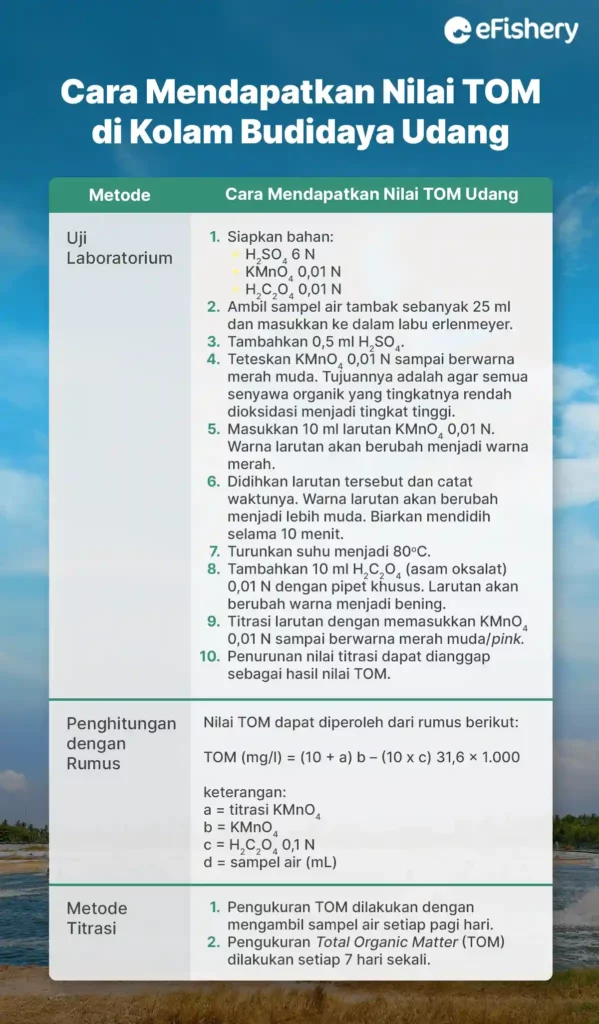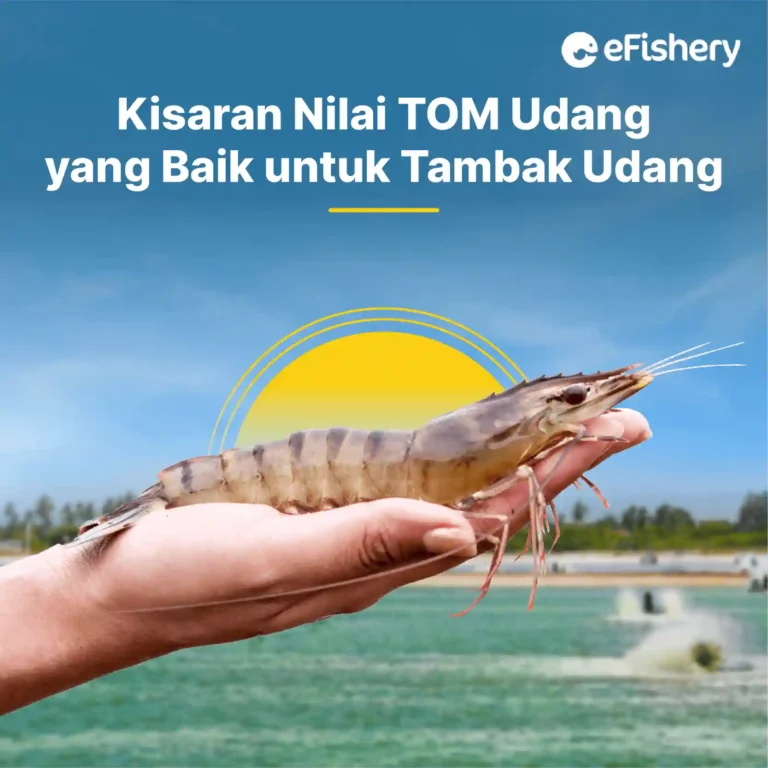Artikel Ini Telah Direview Oleh:

Nabilla Anggi
Magister Budidaya Perairan
One of the water chemistry parameters that you as a farmer must pay attention to is value Optimal shrimp TOM in ponds. TOM or excess organic matter in aquaculture waters is toxic to shrimp and can cause stress symptoms, reduce appetite, trigger disease growth, and even trigger mass death.
There are certain numbers used to describe the number of TOM in shrimp ponds. Let's read further to find out the good TOM values for shrimp ponds and how to control TOM in shrimp ponds!
What is TOM in Shrimp Ponds?
Total Organic Matter (TOM) is an illustration of the amount of dissolved, suspended, and colloidal organic matter in shrimp pond waters. Good organic matter content is 20 ppm, while the maximum limit for organic matter content is 80 ppm (indicating poor water quality).
Physically, the high TOM value can be seen from the condition of the waters. If it is cloudy and smells bad, it means bad water conditions. And vice versa, if the water conditions are relatively clear and odorless, it means that the water conditions are good.
Things That Affect Changes in Shrimp TOM Values
The high and low TOM values in a water are caused by an increase in the accumulation of organic matter that has accumulated at the bottom of pond waters. This worsens the water quality of shrimp ponds. The following things affect the TOM value in a shrimp pond waters:
- Overfeeding (a lot of leftover feed accumulates at the bottom of the pond)
- Biota feces
- Dead organisms (plankton, shrimp, etc.)
- Fertilization that accumulates at the bottom of the pond
- The high turbidity of pond waters
- Increased ammonia in ponds
- Excess klekap (woven-shaped algae that are on the surface of pond water).
How to Get TOM Value in Shrimp Cultivation Ponds

How to Control TOM Value
Some efforts that can be made to control the TOM value are as follows:
- Do feed management, so it doesn't happen overfeeding when there is a decrease in appetite.
- Do siphoning periodically to remove silt and sediment at the bottom of the pond.
- Do a water change when the organic matter content is too high. The amount of water replaced for large ponds is 25-30% of the pool volume, while the amount of water that needs to be replaced for small ponds is 10-20% of the pond volume.
- Increase pond aeration. Optimizing the oxygen concentration in the pond needs to be done to help the decomposition process that occurs at the bottom of the pond. The goal is that the decomposition of organic matter is not hampered and the DO value in the pond can be maintained at > 5 ppm.
- Add probiotics to help decompose organic matter (feed scraps, dead plankton, etc.) at the bottom of the pond.
Need Help Regarding Shrimp Cultivation Business?
Fill in your personal data in the following form. Our team will immediately contact you via the number cellphone attached. Make sure the data entered is correct.
Calculate and Control Shrimp TOM Value with eFarm!
Total organic matter content or Total Organic Matter (TOM) can be a benchmark in controlling organic matter in pond waters. TOM values can be used to evaluate shrimp cultivation harvest plans so that pond quality is maintained even better.
Want to know more about TOM? Or are you still confused about how to control TOM in your pond? Relax, you can get free assistance and consultation from experts through features Cultivation Consultation from eFarm.
eFarm is a shrimp farming management application that provides various shrimp farming solutions for farmers. With eFarmYou can get various tips, tricks, and the right cultivation steps to get a maximum harvest. What are you waiting for? Come on, consult your cultivation in the application eFarm and enjoy various conveniences in shrimp farming!

Nabilla Anggi - Magister Budidaya Perairan
Nabilla merupakan lulusan sarjana dan magister budidaya perairan serta memiliki pengalaman di dunia perikanan baik hatchery maupun pembesaran
Questions Regarding the Range of Good Shrimp TOM Values
Total Organic Matter (TOM) is an illustration of the amount of dissolved, suspended, and colloidal organic matter in shrimp pond waters.
Good organic matter content is 20 ppm, while the maximum limit for organic matter content is 80 ppm (indicating poor water quality).
- Boyd C E. 1995. Bottom Soils, Sediments, and Pond Aquaculture.
- Hadinafta R. 2009. Analysis of Oxygen Demand for Decomposition of Organic Matter in the Base Layer of the Cisadane River Estuary, Tangerang. Thesis. Bogor Agricultural Institute.
- Marganof. 2007. Model of Pollution Control in Lake Maninjau, West Sumatra. Graduate School. Bogor Agricultural Institute.
- Rabiana. 2018. Management of Water Quality in Growing Vaname Shrimp (Litopenaeus Vannamei) in Cv. The Mighty True Marine Bali. Thesis. Department of Aquaculture, Pangkep State Agricultural Polytechnic.
- Supriatna, M. Mahmudi, M. Musa, and Kusriania. 2020. The relationship between pH and water quality parameters in vannamei shrimp (Litopenaeus vannamei) intensive ponds. Journal of Fisheries and Marine Research. 4(3):368-374.
- Sutrisyani and Spiritual. 2009. Practical Guide to Brackish Water Quality Analysis. Edited: Rachmansyah, M. Atmomarsono, and A. Mustafa. Second printing. Aquaculture Research Center, Jakarta. 55 pp.
- Taufiqullah. 2022. Totally organic ingredients. tneutron. net. accessed on 13 January 2022.
